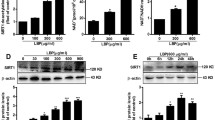Abstract
SIRT1 is a protein deacetylase and regulates glucose and lipid metabolism through its deacetylase activity for a range of substrates. Growing evidence suggests that activation of SIRT1 can treat diseases such as type II diabetes and cardiovascular diseases. Therefore, novel activators of SIRT1 have aroused enormous interests among scientists. The aim of present study is to synthesize new compounds as SIRT1 activators and to investigate their effects on SIRT1 and relevant genes. The three compounds: (3-benzothiazol-2-yl) aniline (JHJ1), N-(3-(benzothiazol-2-yl)phenyl)-3,4,5-trimethoxybenzamide (JHJ2), and N-(3-(benzothiazol-2-yl)phenyl)-1H-pyrazo-3-carboxamide (JHJ3) were synthesized and their effects on SIRT1 and relevant genes to regulate glucose and lipid metabolism in high-fat diet fed C57BL/6J mice were also addressed. The results showed that relative mRNA expressions of SIRT1, FoxO1, PPARγ, and PGC-1α were significantly up-regulated in the liver, and the glucose, plasma total-cholesterol, hepatic cholesterol, and total triglyceride concentration were markedly lowered by JHJ1, JHJ2, and JHJ3 supplementation, respectively. These results suggest that benzothiazole derivatives HJ1, JHJ2, and JHJ3 supplementation could modulate the plasma lipids metabolism and blood glucose-lowering action in high-fat fed mice through regulation of SIRT1 and relevant genes.





Similar content being viewed by others
Abbreviations
- SIRT1:
-
Silent information regulator 1
- FoxO1:
-
Forkhead box O1
- PPARγ:
-
Peroxisome proliferators activated receptor γ
- PGC-1α:
-
Peroxisome proliferator-activated receptor gamma coactivator 1-alpha
- HDL-C:
-
High-density lipoprotein cholesterol
- total-C:
-
Total-cholesterol
- TG:
-
Triglycerides
- PPA:
-
Polyphosphoric acid
- EDCI:
-
N-(3-Dimethylaminopropyl)-N′-ethylcarbodiimide hydrochloride
- Et3N:
-
Triethylamine
- DMAP:
-
4-Dimethylamiopryidine
References
Antonello M, Sergio V, Sarah M (2009) Study of 1, 4-dihydropyridine structural scaffold: discovery of novel sirtuin activators and inhibitors. J Med Chem 52:5496–5504
Baron AD (1998) Postprandial hyperglycemia and α-glucosidase inhibitors. Diabetes Res Clin Pract 40:51–55
Cantó C, Auwerx J (2009) PGC-1alpha, SIRT1 and AMPK, an energy sensing network that controls energy expenditure. Curr Opin Lipidol 20:98–105
Chang S, Graham B, Yakubu F (1990) Metabolic differences between obesity-prone and obesity-resistant rats. Am J Physiol 259:1103–1110
DeFronzo RA (1999) Pharmacologic therapy for type 2 diabetes mellitus. Ann Intern Med 131:281–303
Ghibaudi L, Cook J, Farley C (2002) Fat intake affects adiposity, comorbidity factors, energy metabolism of sprague-dawley rats. Obes Res 10:956–963
Giannakou ME, Partridge L (2004) The interaction between FOXO and SIRT1: tipping the balance towards survival. Trends Cell Biol 14:408–412
Higashida K, Kim SH, Jung SR, Asaka M, Holloszy JO, Han DH (2014) Correction: effects of resveratrol and SIRT1 on PGC-1a activity and mitochondrial biogenesis: a reevaluation. PLoS Biol 12(1): 1–3, 3
Jean EB, Chi BV, Roger X (2009) Discovery of oxazolo[4,5-b] pyridines and related heterocyclic analogs as novel SIRT1 activators. Bioorg Med Chem Lett 19:2350–2353
Juhan-Vague I, Alessi MC (1997) PAI-1, obesity, insulin resistance and risk of cardiovascular events. Thromb Haemost 78:656–660
Kitamura YI, Kitamura T, Kruse JP, Raum JC, Stein R, Gu W, Accili D (2005) FOXO1 protects against pancreatic beta cell failure through NeuroD and MafA induction. Cell Metab 2:153–163
Michishita E, Park JY, Burneskis JM (2005) Evolutionarily conserved and nonconserved cellular localizations and functions of human SIRT proteins. Mol Biol Cell 16:4623–4635
Milne JC, Lambert PD, Schenk S (2007) Small molecule activators of SIRT1 as therapeutics for the treatment of type 2 diabetes. Nature 450:712–716
Nayagam VM, Wang X, Tan YC (2006) SIRT1 modulating compounds from high-throughput screening as anti-inflammatory and insulin- sensitizing agents. J Biomol Screen 11:959–967
Picard F, Kurtev M, Chung N, Topark-Ngarm A, Senawong T, Machado R, Leid M, McBurney MW, Guarente L (2004) SIRT1 promotes fat mobilization in white adipocytes by repressing PPARγ. Nature 429:771–776
Polonsky K, Sturis J, Bell GI (1996) Non-insulin-dependent diabetes mellitus a genetically programmed failure of the beta cell to compensate for insulin resistance. N Engl J Med 334:777–783
Poritsanos NJ, Wong D, Vrontakis ME (2008) Regulation of hepatic PPAR gamma2 and lipogenic gene expression by melanocortin. Biochem Biophys Res Commun 376:384–388
Rodgers JT, Lerin C, Haas W, Gygi SP, Bruce M, Puigserver P (2005) Nutrient control of glucose homeostasis through a complex of PGC-1α and SIRT1. Nature 434:113–118
Seung-Hong L, Kwan-Hee M, Ji-Sook H (2012) Effects of brown alga, Ecklonia cava on glucose and lipid metabolism in C57BL/KsJ-db/db mice, a model of type 2 diabetes mellitus. Food Chem Toxicol 50:575–582
Sin TK, Yu AP, Yung BY, Yip SP, Chan LW, Wong CS, Ying M, Rudd JA, Siu PM (2014) Modulating effect of SIRT1 activation induced by resveratrol on Foxo1-associated apoptotic signalling in senescent heart. J Physiol 592(12):2535–2548
Tang BL, Chua CE (2008) SIRT1 and neuronal diseases. Mol Aspects Med 29:187–200
Zimmet P, Alberti K, Shaw J (2001) Global and societal implications of the diabetes epidemic. Nature 414:782–787
Acknowledgments
This work was supported by Grants from the National Natural Science Foundation of China (Grant no. 81072521) and Tianjin University of Science & Technology (Grant No. 20100411).
Author information
Authors and Affiliations
Corresponding author
Rights and permissions
About this article
Cite this article
Gu, Q., Zhou, P., Xu, X. et al. Benzothiazole derivatives upregulate SIRT1 and relevant genes in high-fat fed C57BL/6J mice. Med Chem Res 24, 2454–2460 (2015). https://doi.org/10.1007/s00044-014-1307-3
Received:
Accepted:
Published:
Issue Date:
DOI: https://doi.org/10.1007/s00044-014-1307-3




